Tuesday, July 27, 2004
Ocean in View! Oh the Joy!
These were the words of Meriweather Lewis upon reaching the end of the Columbia River and viewing the Pacific Ocean. They left Camp Wood near St. Louis on May 14, 1804 in search of a water passage to the Pacific. They arrived at the Pacific on November 7, 1805. A total of 542 days.
We left St. Louis on June 16, 2004 and arrived at the Pacific on July 26, 2004. A total of 40 days.
It HAS been a long time since we've seen the Pacific Ocean. I lived in California from '73 to '83 and spent much time along the Pacific coast. Jim and I went there together in '94. So, it's been at least 10 years. It IS different from the Atlantic.
Black volcanic sand:
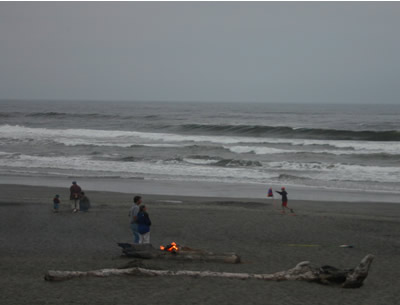
And, cliffs overlooking the ocean:
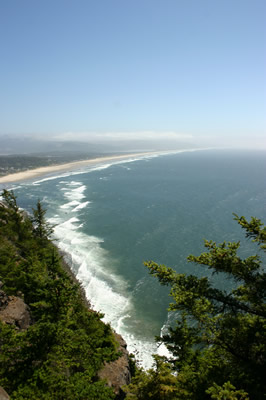
Even though it's been mostly by accident, we have really enjoyed following the Lewis and Clark trail. Along the way, we've seen several visitor centers telling the tale about their journey thru that particular area. There are a few things I am particularly impressed with about the Lewis and Clark Expedition, aka the 'Corps of Discovery'.
1. It was a military endeavor, yet it had two 'Co-captains' of equal rank and respect. No account of the story has anything but glowing words to say about the leadership of the expedition. These 2 equal co-captains were very wise in the way of teamwork. They spent the entire winter at Camp Dubois assembling their team. They knew that endurance would be a key factor. Those who couldn't endure that first winter were weeded out. Those that made it were valued.
2. NO ONE died as a result of the journey. I am incredulous over this one. They traveled thru unknown territory, bore unthinkable hardships, grizzly bears, canoeing over waterfalls, freezing temperatures, no food ... it goes on and on. One corps member did die in the early days of the expedition, but he died of appendicitis, this would have been a killer no matter where he was. All 33 who undertook the entire journey, made it to the Pacific AND back to St. Louis on September 23, 1806. See a timeline of the entire expedition here.
3. The expedition would not have made it without the assistance of the Native Americans along the way. The Shoshone girl, Sacagawea, was the wife of Toussaint Charbonneau. Toussaint was hired as an interpreter, but it was his wife who really did the interpreting - and a lot of the guiding. She also was prized as being calm under pressure. It was her efforts that saved many important cargo items when the canoes capsized going thru the rapids. And, she had a 2 month old baby on her back at the time. (Her story reminds me of the story of Fred Astaire and Ginger Rogers ... SHE did everything he did only in high heels and backwards!) And, she was only 17. Other stories of help included getting food and shelter from the Nez Perce, horses from the Shoshone and canoes from the Clatsop. The corps were under orders from President Jefferson to develop peace and friendship with the natives.
4. It is unclear exactly what happened to Meriweather Lewis, but all indications are that he committed suicide in 1809. I wonder if it had anything to do with the knowledge of how the Indians were being annihilated by those who later followed his trail. All accounts, however, are that he suffered from moodiness, which escalated to severe depression after the journey had ended.
5. Sacagawea's baby, Jean-Baptiste Charbonneau, was raised by William Clark and went on to great adventures around the globe. I'd love to read his autobiography!
So, we've turned south now and are following the Oregon coastline. Our partnership with Lewis and Clark has ended. Our last visit was at Fort Clatsop Memorial near the mouth of the Columbia. Our shuttle bus driver felt compelled to apologize for the sunny day, since, he expected we would rather have the more authentic experience of cold and rain! This is where the Corps spent the winter of 1805 and only saw 6 sunny days. Here I am noting the one area of the journey that we didn't see ... Great Falls Montana.
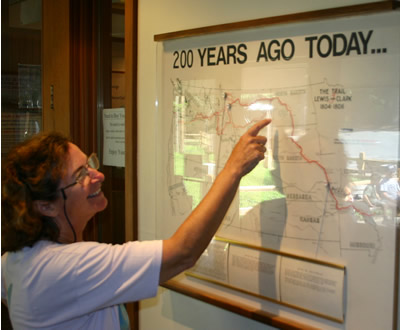
They have a replica of the fort and costumed guides to talk to. It's a gorgeous forested area.
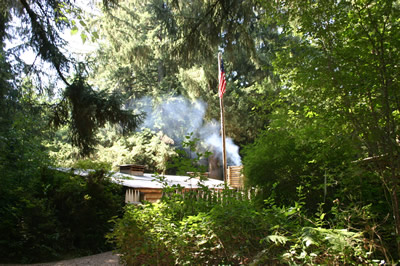
Here is one of the costumed volunteers complete with a replica of William Clark's dog, a Newfoundland named 'Seaman'.
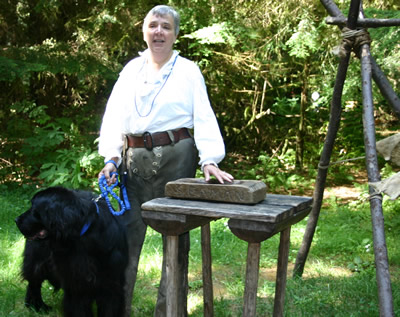
Back on the road now, on the Pacific Coast Highway.
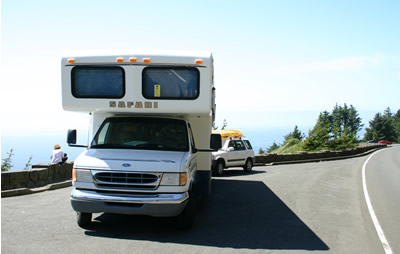
These were the words of Meriweather Lewis upon reaching the end of the Columbia River and viewing the Pacific Ocean. They left Camp Wood near St. Louis on May 14, 1804 in search of a water passage to the Pacific. They arrived at the Pacific on November 7, 1805. A total of 542 days.
We left St. Louis on June 16, 2004 and arrived at the Pacific on July 26, 2004. A total of 40 days.
It HAS been a long time since we've seen the Pacific Ocean. I lived in California from '73 to '83 and spent much time along the Pacific coast. Jim and I went there together in '94. So, it's been at least 10 years. It IS different from the Atlantic.
Black volcanic sand:

And, cliffs overlooking the ocean:

Even though it's been mostly by accident, we have really enjoyed following the Lewis and Clark trail. Along the way, we've seen several visitor centers telling the tale about their journey thru that particular area. There are a few things I am particularly impressed with about the Lewis and Clark Expedition, aka the 'Corps of Discovery'.
1. It was a military endeavor, yet it had two 'Co-captains' of equal rank and respect. No account of the story has anything but glowing words to say about the leadership of the expedition. These 2 equal co-captains were very wise in the way of teamwork. They spent the entire winter at Camp Dubois assembling their team. They knew that endurance would be a key factor. Those who couldn't endure that first winter were weeded out. Those that made it were valued.
2. NO ONE died as a result of the journey. I am incredulous over this one. They traveled thru unknown territory, bore unthinkable hardships, grizzly bears, canoeing over waterfalls, freezing temperatures, no food ... it goes on and on. One corps member did die in the early days of the expedition, but he died of appendicitis, this would have been a killer no matter where he was. All 33 who undertook the entire journey, made it to the Pacific AND back to St. Louis on September 23, 1806. See a timeline of the entire expedition here.
3. The expedition would not have made it without the assistance of the Native Americans along the way. The Shoshone girl, Sacagawea, was the wife of Toussaint Charbonneau. Toussaint was hired as an interpreter, but it was his wife who really did the interpreting - and a lot of the guiding. She also was prized as being calm under pressure. It was her efforts that saved many important cargo items when the canoes capsized going thru the rapids. And, she had a 2 month old baby on her back at the time. (Her story reminds me of the story of Fred Astaire and Ginger Rogers ... SHE did everything he did only in high heels and backwards!) And, she was only 17. Other stories of help included getting food and shelter from the Nez Perce, horses from the Shoshone and canoes from the Clatsop. The corps were under orders from President Jefferson to develop peace and friendship with the natives.
4. It is unclear exactly what happened to Meriweather Lewis, but all indications are that he committed suicide in 1809. I wonder if it had anything to do with the knowledge of how the Indians were being annihilated by those who later followed his trail. All accounts, however, are that he suffered from moodiness, which escalated to severe depression after the journey had ended.
5. Sacagawea's baby, Jean-Baptiste Charbonneau, was raised by William Clark and went on to great adventures around the globe. I'd love to read his autobiography!
So, we've turned south now and are following the Oregon coastline. Our partnership with Lewis and Clark has ended. Our last visit was at Fort Clatsop Memorial near the mouth of the Columbia. Our shuttle bus driver felt compelled to apologize for the sunny day, since, he expected we would rather have the more authentic experience of cold and rain! This is where the Corps spent the winter of 1805 and only saw 6 sunny days. Here I am noting the one area of the journey that we didn't see ... Great Falls Montana.

They have a replica of the fort and costumed guides to talk to. It's a gorgeous forested area.

Here is one of the costumed volunteers complete with a replica of William Clark's dog, a Newfoundland named 'Seaman'.

Back on the road now, on the Pacific Coast Highway.

posted by Chris at 7/27/2004 09:15:00 PM